The back and biceps are fundamental components of our upper body strength. A well-planned dumbbell workout can help you target these areas precisely, leading to increased muscle mass, improved fitness, and greater overall physical capability. By incorporating a variety of exercises, we can ensure you develop a balanced, powerful upper body that not only looks great but also performs at its peak.
Why Do a Back and Bicep Dumbbell Workout?
A strong, well-balanced physique requires a comprehensive training plan that targets all muscle groups, and the back and bicep muscles are no exception. The back and biceps make up some of the largest muscle groups in the upper body, with the back comprising over 70% of your upper body’s musculature. Additionally, these muscles play a crucial role in everyday activities such as pulling, lifting, and carrying objects. Therefore, incorporating a back and bicep dumbbell workout into your routine can improve both your functional strength and overall fitness.
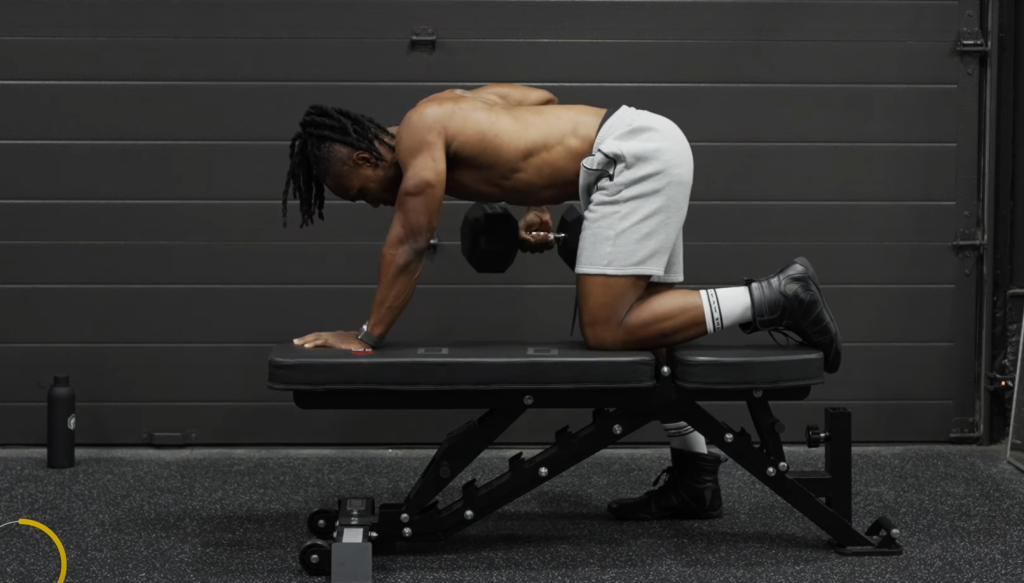
Benefits of Back and Bicep Dumbbell Workouts
Doing regular back and bicep dumbbell exercises offers numerous benefits beyond just aesthetic gains. Here are some reasons why you should consider adding this workout to your routine:
1. Increased Muscle Strength and Size
Dumbbell exercises target specific muscles, allowing for better isolation and control during each repetition. This results in increased muscle strength and size over time, helping you build a bigger, more defined back and biceps.
2. Improved Posture
Strong back muscles are essential for maintaining good posture and preventing back pain. Incorporating back exercises in your workout routine can help strengthen the muscles that support your spine, leading to improved posture and reduced risk of injury.
3. Better Functional Strength
Since our backs and biceps play a crucial role in everyday activities, working these muscles with dumbbell exercises translates to better functional strength. This means you’ll have an easier time performing daily tasks such as carrying heavy objects, pulling yourself up, and even improving your athletic performance. [1]
4. Versatility and Convenience
Back and bicep dumbbell exercises offer a wide range of options that can target different muscle groups within these areas. Additionally, you can perform these exercises at home or in the gym with just a set of dumbbells, making them a convenient and versatile workout option.
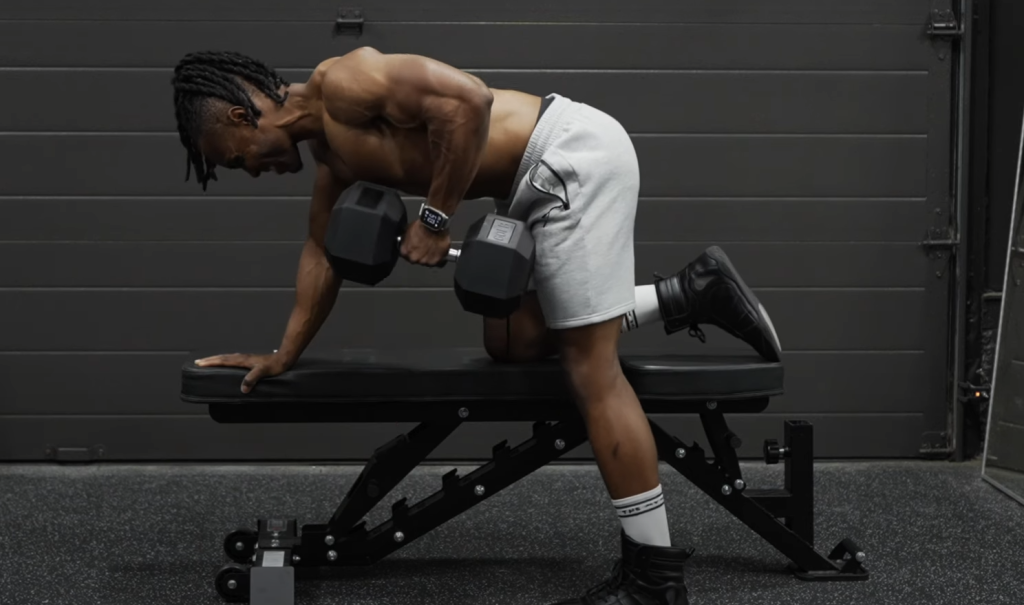
12 Key Exercises for a Back and Bicep Dumbbell Workout
To get the most out of your back and bicep dumbbell workout, here are some key exercises to include in your routine:
1. Bent-Over Rows
This exercise primarily targets the lats (large muscles on the sides of your back) and also works the biceps, traps, and rear deltoids (muscles at the back of your shoulders). To perform this exercise, stand with feet shoulder-width apart, holding a dumbbell in each hand. Bend at the hips to lower your torso until it’s almost parallel with the floor. Keeping your arms close to your sides and elbows pointing backward, pull the dumbbells up towards your chest. Lower them back down slowly and repeat.
2. Deadlifts
Another effective full-body exercise, deadlifts target the entire back, including the lats and traps, as well as the biceps. To do this exercise, stand with feet shoulder-width apart, holding a dumbbell in each hand with palms facing your body. Keeping your back straight, bend at the hips and knees to lower the dumbbells towards the ground until you feel a stretch in your hamstrings. Push through your heels to stand back up and repeat. [2]
3. Hammer Curls
This bicep-focused exercise also targets the forearms, making it an excellent addition to any back and bicep dumbbell workout. To perform a hammer curl, hold a dumbbell in each hand with palms facing your body and arms by your sides. Keeping your elbows close to your body, slowly raise the dumbbells towards your shoulders. Lower them back down and repeat.
4. Chin-Ups
Chin-ups are a classic compound exercise that primarily works the biceps, but also engages the lats and other back muscles. To do this exercise, grab a pull-up bar with an underhand grip (palms facing towards you) and hang with arms fully extended. Pull yourself up until your chin is above the bar, then slowly lower down and repeat.
5. Inverted Rows
Inverted rows are a great way to target the back muscles without using any weights. To perform this exercise, lie under a sturdy bar (such as a Smith machine) or use a suspension trainer like TRX. Grip the bar with hands shoulder-width apart and extend your arms fully. Pull yourself up towards the bar by squeezing your shoulder blades together, then slowly lower down and repeat.
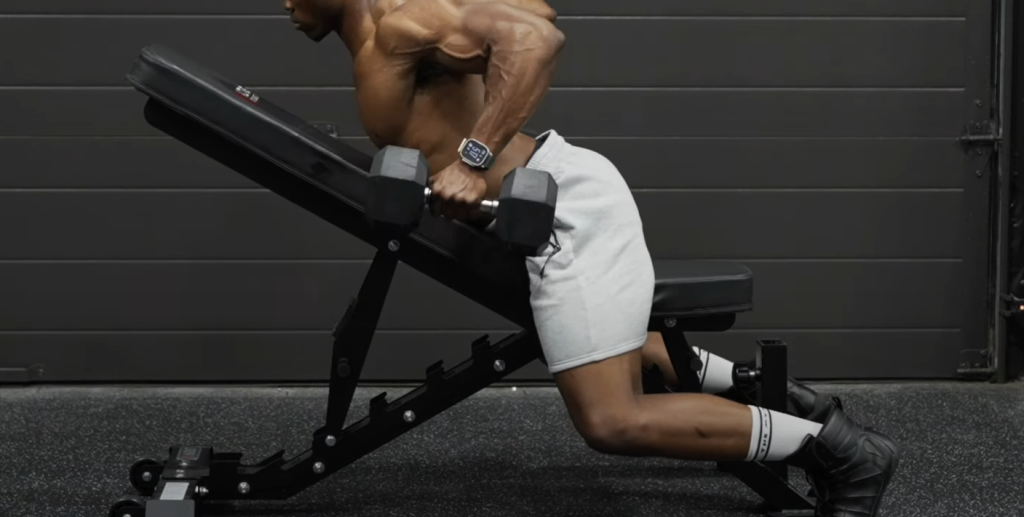
6. Concentration Curls
This bicep isolation exercise is great for targeting each arm individually, helping to even out any strength imbalances. To do this exercise, sit on a bench with a dumbbell in one hand and elbow resting against your inner thigh. Slowly curl the weight towards your shoulder, then lower back down and repeat. Switch arms and repeat.
7. Dumbbell Shrugs
Shrugs are an effective way to target the trapezius muscles, which run along the upper back and neck. To do this exercise, hold a dumbbell in each hand with arms by your sides and palms facing towards your body. Shrug your shoulders up towards your ears, then slowly lower them back down and repeat. [3]
8. Reverse Flys
Reverse flys engage the rear deltoids and upper back muscles, helping to improve posture and strengthen the shoulders. To perform this exercise, stand with feet shoulder-width apart, holding a dumbbell in each hand with palms facing towards your body. Bend slightly at the knees and hinge forward at the hips while keeping your back straight. Raise the dumbbells out to the sides until your arms are parallel with the floor, then slowly lower them back down and repeat.
9. Preacher Curls
Preacher curls target the biceps while also engaging the forearms for a complete arm workout. To do this exercise, sit at a preacher bench with arms resting on the pad and a dumbbell in each hand. Slowly curl the weights towards your shoulders, then lower them back down and repeat.
10. Calf Raises
Calf raises may not seem like an exercise for the back or biceps, but they help to strengthen the calves, which play a supportive role in many upper body exercises. To do this exercise, stand with feet shoulder-width apart, holding a dumbbell in each hand. Raise your heels off the ground until you’re standing only on your toes, then slowly lower back down and repeat.

11. Reverse Curls
Reverse curls target the brachioradialis muscle in the forearm, helping to improve grip strength and overall arm stability. To perform this exercise, stand with feet shoulder-width apart and hold a dumbbell in each hand with palms facing towards your body. Keeping your elbows close to your sides, curl the weights towards your shoulders, then slowly lower them back down and repeat. [4]
12. Bent-Over Reverse Flys
Similar to reverse flys, this exercise targets the rear deltoids but also engages the lats for a more complete back workout. To do this exercise, stand with feet shoulder-width apart and hold a dumbbell in each hand with palms facing towards your body. Bend at the hips to lower your torso until it’s almost parallel with the floor. Keeping your arms straight, raise the dumbbells out to the sides until they are parallel with the ground, then slowly lower them back down and repeat.
Now that you have some key exercises to add to your routine, remember to always start with proper form and gradually increase weight as your strength improves. And don’t forget the importance of rest days for muscle recovery!
Proper Form for a Back and Bicep Dumbbell Workout
When performing any exercise, it’s important to maintain proper form in order to avoid injury and get the most out of your workout. Here are some tips for maintaining proper form during a back and bicep dumbbell workout:
- Keep your back straight: This is especially important when performing exercises like deadlifts or bent-over rows. Avoid rounding or arching your back to prevent strain.
- Engage your core: Your core muscles help stabilize your body during exercises, so be sure to engage them and keep them tight throughout the workout.
- Use a controlled pace: Avoid using momentum or swinging weights to complete an exercise. Instead, use slow and controlled movements for maximum muscle engagement.
- Focus on mind-muscle connection: Visualize the muscles you are targeting and focus on engaging them throughout the movement.
- Don’t sacrifice form for weight:It may be tempting to lift heavier weights, but it’s important to prioritize proper form over weight. This will help prevent injury and ensure that you’re effectively targeting the intended muscles.
- Listen to your body: If you experience any pain or discomfort during an exercise, stop and reassess your form. It’s better to lower the weight or modify the movement than risk injury.
By following these tips for proper form, you can ensure a safe and effective back and bicep dumbbell workout. Remember to always warm up before exercising and cool down afterwards, and consult with a fitness professional if you have any questions or concerns about your form.
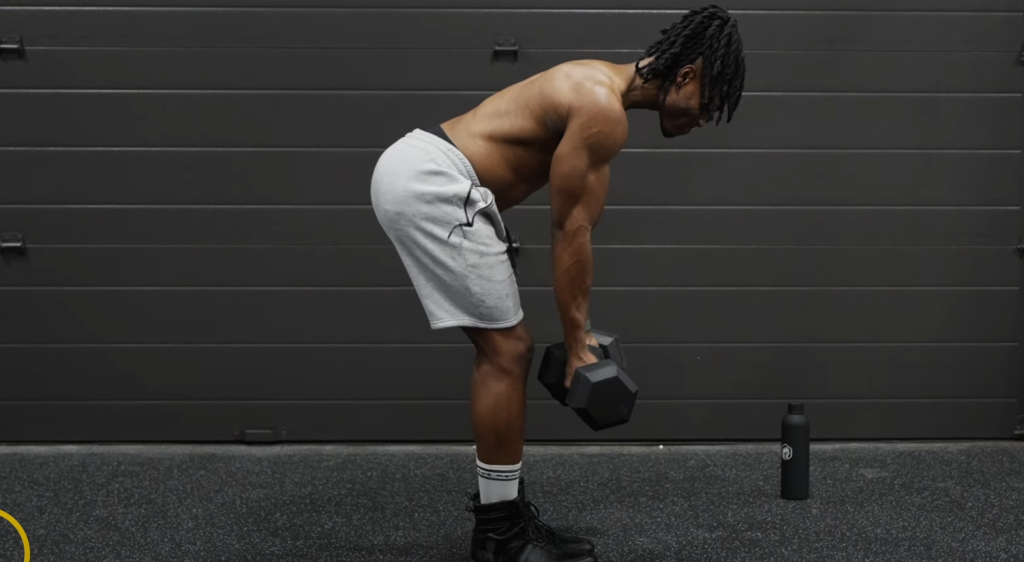
Important Things to Consider Before Starting the Workout
Before starting any new workout routine, there are a few important things to consider. Here are some factors to keep in mind before diving into a back and bicep dumbbell workout:
- Consult with a doctor:If you have any pre-existing health conditions or injuries, it’s important to consult with a doctor before starting a new exercise regimen.
- Start slow and progress gradually:It can be tempting to jump right into a challenging workout, but it’s important to start at your current fitness level and gradually build up intensity and weight over time.
- Choose appropriate weights:Select weights that challenge you, but also allow you to maintain proper form. If you find yourself struggling or sacrificing form, lower the weight.
- Rest and recover:Giving your muscles time to rest and repair is crucial for avoiding injury and seeing progress. Be sure to take rest days and listen to your body if you feel fatigued or sore.
- Fuel your body properly:Eating a balanced diet with enough protein, carbohydrates, and healthy fats is important for fueling your body during a workout and aiding in recovery afterwards. [5]
By considering these factors and prioritizing safety, you can set yourself up for a successful back and bicep dumbbell workout. Remember to listen to your body, stay hydrated, and have fun with it! So get those dumbbells ready and start working towards a stronger back and biceps.
Sample Back and Bicep Dumbbell Workout Routine
Here is a sample workout routine incorporating the exercises mentioned above. Remember to start with a warm-up and cool down, and adjust weights as needed based on your own fitness level:
- Bent-Over Rows:3 sets of 10 reps
- Hammer Curls:3 sets of 12 reps each arm
- Deadlifts: 3 sets of 8 reps
- Reverse Flys:3 sets of 10 reps
- Concentration Curls: 3 sets of 12 reps each arm
- Pull-Ups:3 sets to failure (or use resistance bands for assistance)
- Calf Raises:3 sets of 15 reps
- Reverse Curls:3 sets of 12 reps
- Bent-Over Reverse Flys:3 sets of 10 reps
Remember to rest for 60-90 seconds between each set and stretch afterwards. As you progress, consider increasing weights or adding additional sets to challenge yourself.
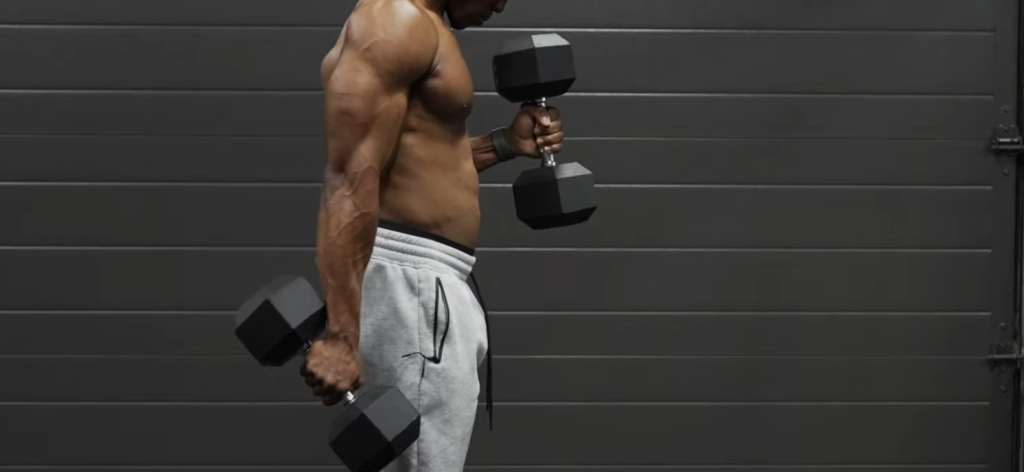
Cooling Down After a Workout Session
After completing a back and bicep dumbbell workout, it’s important to take the time to properly cool down and stretch your muscles. This can help prevent injury and improve muscle recovery. Here are some key stretches to include in your post-workout routine:
- Triceps Stretch:Stand with feet shoulder-width apart and raise one arm straight up, then bend at the elbow to bring your hand behind your head. Use your other arm to gently pull on the bent elbow, stretching the tricep muscle. Hold for 15-30 seconds and repeat on the other arm.
- Standing Forward Bend:Stand with feet hip-width apart and slowly bend at the waist, reaching towards your toes or as far as you comfortably can. Hold for 15-30 seconds and slowly come back up.
- Shoulder Cross Stretch:Stand with feet shoulder-width apart, cross one arm in front of your chest and use the other arm to gently pull on the elbow, stretching the back of the shoulder. Hold for 15-30 seconds and repeat on the other arm.
- Chest Stretch:Stand with feet shoulder-width apart and interlace your fingers behind your back. Slowly raise your arms towards the ceiling, stretching your chest muscles. Hold for 15-30 seconds.
It’s also important to drink plenty of water and refuel with a balanced meal or snack after your workout. Taking care of your body before, during, and after exercise is key to seeing progress and preventing injury. Remember, consistency is key – so keep up with your back and bicep dumbbell workouts to see improvements in strength and muscle definition over time.
Tips for an Effective Back and Bicep Dumbbell Workout
In addition to proper form and safety considerations, here are a few additional tips for an effective back and bicep dumbbell workout:
- Vary your workouts:Don’t be afraid to switch up your exercises or try new variations. This can help prevent boredom and target different muscle groups.
- Incorporate supersets:Supersets involve performing two exercises back-to-back without rest, which can help increase intensity and save time during a workout.
- Track your progress:Whether it’s using a fitness app or simply writing down your weights and reps, tracking your progress can help motivate you and show how far you’ve come.
- Get enough rest:As mentioned earlier, rest is crucial for muscle recovery. Aim for 7-9 hours of sleep each night and avoid over-exhausting your muscles with back-to-back workouts.
With these tips in mind, you can make the most out of your back and bicep dumbbell workout routine. Remember to listen to your body, stay safe, and have fun while working towards a stronger and more defined upper body. [6]
When to Incorporate a Back and Bicep Dumbbell Workout into Your Routine
A back and bicep dumbbell workout can be incorporated into a variety of fitness routines, depending on your goals and preferences. Here are a few ideas for when to include this type of workout:
- Upper body split:If you prefer to focus on specific muscle groups each day, consider incorporating back and bicep exercises into an upper body split routine, with a focus on other muscle groups on different days.
- Full-body workout:You can also incorporate back and bicep exercises into a full-body workout routine by including them alongside exercises for other muscle groups.
- At-home workouts:This type of workout is perfect for at-home routines, as it only requires a set of dumbbells and minimal space.
Ultimately, the best time to incorporate a back and bicep dumbbell workout into your routine is when it fits best for you and your schedule. As long as you prioritize safety and proper form, this workout can be beneficial for all fitness levels. So grab those dumbbells and get ready to strengthen and sculpt your upper body! Keep pushing yourself, staying consistent, and remember to have fun with it. Your back and biceps will thank you.
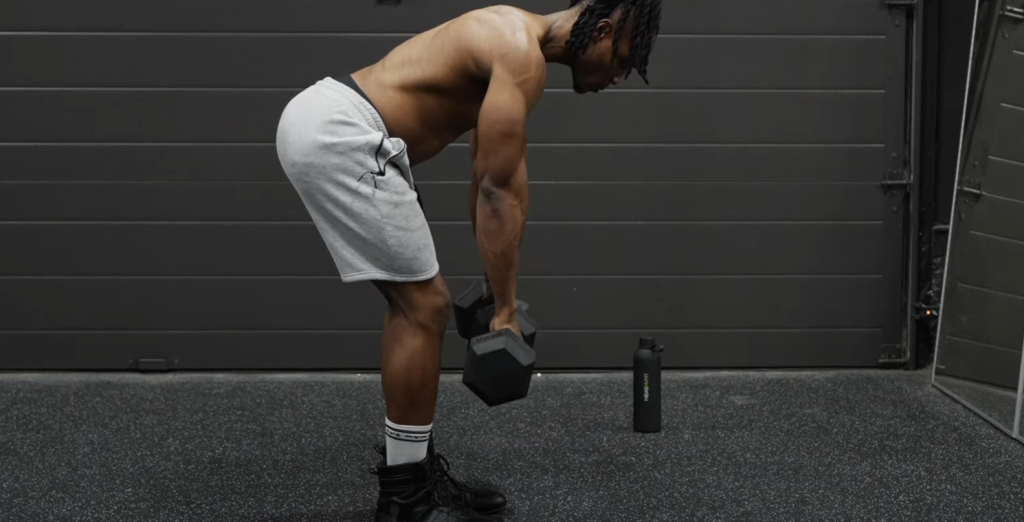
FAQs
What are the benefits of a back and bicep dumbbell workout?
There are numerous benefits to incorporating a back and bicep dumbbell workout into your fitness routine. Some of the main benefits include:
- Improved muscle strength and definition: As you perform exercises targeting your back and bicep muscles, you will gradually increase their strength and size.
- Increased stability and balance: Dumbbells require more stabilization than machines, meaning that your body has to work harder to maintain proper form and balance, leading to improved stability.
- Versatility: Dumbbells allow for a wide range of exercises that can target different muscles in your back and biceps, making it easier to achieve a well-rounded workout.
- Convenience: Dumbbells are compact and portable, making them easy to store at home or bring to the gym, allowing for a convenient workout routine.
- Reduced risk of injury: With dumbbells, you have more control over the weight and movements, making it easier to avoid strain or injury.
Can I do a back and bicep dumbbell workout at home?
Yes, absolutely! Dumbbell workouts can easily be done at home with minimal equipment and space. This makes it a convenient option for those who prefer to workout at home or do not have access to a gym.
How often should I do a back and bicep dumbbell workout?
It is recommended to perform strength training exercises, such as a back and bicep dumbbell workout, 2-3 times per week with at least one day of rest in between sessions. However, it is essential to listen to your body and adjust the frequency based on your fitness level and recovery time.
Can I replace a back and bicep dumbbell workout with machine exercises?
While machine exercises can also target the back and bicep muscles, they do not offer the same range of motion and stability required in dumbbell exercises. It is recommended to incorporate both in your workout routine for optimal results.
Are there any specific tips for beginners?
For beginners, it is essential to start with light weights and focus on proper form and technique before increasing the weight. Gradually increase the weight as you become more comfortable and confident with the exercises. Additionally, it is crucial to warm up before starting a dumbbell workout to prevent injury and cool down afterward to aid in muscle recovery. Consulting a professional trainer or doing research on proper form is also highly recommended for beginners. So, if you are new to a back and bicep dumbbell workout, take it slow and focus on building a strong foundation first.
What size dumbbells should I use for this workout?
The size of dumbbells used will depend on your fitness level and the specific exercises you are doing. As a general guideline, choose a weight that allows you to perform 12-15 reps while maintaining proper form. If the weight is too light or too heavy, adjust accordingly to achieve this rep range. Remember, it’s better to start with lighter weights and gradually increase as needed rather than risk injury by lifting too heavy. Overall, the weight used should challenge your muscles without jeopardizing proper form.
How long should a back and bicep dumbbell workout last?
The length of a back and bicep dumbbell workout can vary depending on factors such as intensity, rest time between sets, and number of exercises performed. On average, a back and bicep dumbbell workout can take 30-45 minutes to complete. However, the focus should be on quality rather than quantity, so it’s important to allow for proper rest and recovery time in between sets.
What other muscle groups can be targeted with dumbbells?
Dumbbells are versatile tools that can target various muscle groups, including chest, shoulders, triceps, legs, and core. You can easily modify exercises to target different muscles by changing your grip or stance or incorporating additional movements. So, don’t be afraid to get creative with dumbbells in your workout routine!
What if I don’t feel the burn in my biceps during the workout?
If you don’t feel the burn in your biceps during a back and bicep dumbbell workout, it could be due to several factors. It’s crucial to check that you are using proper form and engaging the correct muscles during each exercise. Additionally, you may need to increase the weight or try different variations of exercises to target your biceps more effectively. Consulting a professional trainer can also help identify and correct any issues with your bicep activation.
Conclusion
Incorporating a back and bicep dumbbell workout into your fitness routine can offer numerous benefits, including improved muscle strength and definition, increased stability and balance, versatility, convenience, and reduced risk of injury. Whether you are a beginner or experienced gym-goer, incorporating dumbbell exercises for your back and biceps is a great way to achieve a well-rounded workout. Remember to start with lighter weights, focus on proper form, and gradually increase the weight as needed for optimal results. Don’t forget to also listen to your body and adjust the frequency of workouts accordingly. With dedication and consistency, you can achieve your fitness goals and see improvements in no time! So, grab those dumbbells and get ready to feel the burn in your back and biceps. Happy lifting!
Useful Video: 20 MIN BACK AND BICEP WORKOUT | BACK AND BICEP DUMBBELL WORKOUT
References:
- https://www.self.com/gallery/back-and-biceps-workout-with-dumbbells
- https://www.bodybuildingmealplan.com/dumbbell-back-and-bicep-workout/
- https://www.menshealth.com/uk/workouts/a42570977/dumbbell-only-back-and-biceps-workout/
- https://www.womenshealthmag.com/fitness/g28759770/back-and-bicep-workout/
- https://www.menshealth.com/uk/workouts/g755928/the-back-and-biceps-drop-set-workout/
- https://www.verywellfit.com/back-and-biceps-workout-1231471

